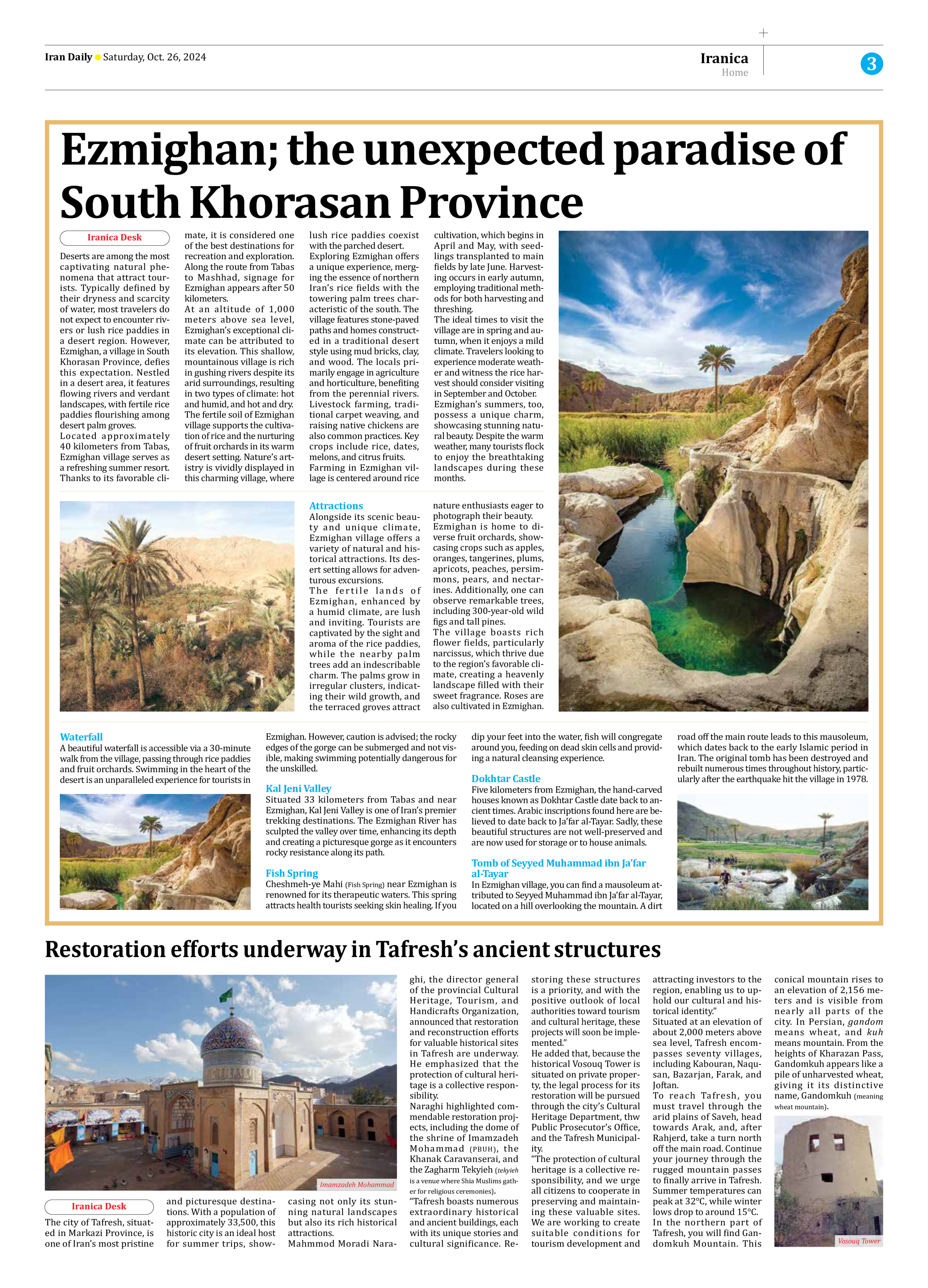
Ezmighan; the unexpected paradise of South Khorasan Province
Deserts are among the most captivating natural phenomena that attract tourists. Typically defined by their dryness and scarcity of water, most travelers do not expect to encounter rivers or lush rice paddies in a desert region. However, Ezmighan, a village in South Khorasan Province, defies this expectation. Nestled in a desert area, it features flowing rivers and verdant landscapes, with fertile rice paddies flourishing among desert palm groves.
Located approximately 40 kilometers from Tabas, Ezmighan village serves as a refreshing summer resort. Thanks to its favorable climate, it is considered one of the best destinations for recreation and exploration. Along the route from Tabas to Mashhad, signage for Ezmighan appears after 50 kilometers.
At an altitude of 1,000 meters above sea level, Ezmighan’s exceptional climate can be attributed to its elevation. This shallow, mountainous village is rich in gushing rivers despite its arid surroundings, resulting in two types of climate: hot and humid, and hot and dry.
The fertile soil of Ezmighan village supports the cultivation of rice and the nurturing of fruit orchards in its warm desert setting. Nature’s artistry is vividly displayed in this charming village, where lush rice paddies coexist with the parched desert.
Exploring Ezmighan offers a unique experience, merging the essence of northern Iran’s rice fields with the towering palm trees characteristic of the south. The village features stone-paved paths and homes constructed in a traditional desert style using mud bricks, clay, and wood. The locals primarily engage in agriculture and horticulture, benefiting from the perennial rivers. Livestock farming, traditional carpet weaving, and raising native chickens are also common practices. Key crops include rice, dates, melons, and citrus fruits.
Farming in Ezmighan village is centered around rice cultivation, which begins in April and May, with seedlings transplanted to main fields by late June. Harvesting occurs in early autumn, employing traditional methods for both harvesting and threshing.
The ideal times to visit the village are in spring and autumn, when it enjoys a mild climate. Travelers looking to experience moderate weather and witness the rice harvest should consider visiting in September and October.
Ezmighan’s summers, too, possess a unique charm, showcasing stunning natural beauty. Despite the warm weather, many tourists flock to enjoy the breathtaking landscapes during these months.
Attractions
Alongside its scenic beauty and unique climate, Ezmighan village offers a variety of natural and historical attractions. Its desert setting allows for adventurous excursions.
The fertile lands of Ezmighan, enhanced by a humid climate, are lush and inviting. Tourists are captivated by the sight and aroma of the rice paddies, while the nearby palm trees add an indescribable charm. The palms grow in irregular clusters, indicating their wild growth, and the terraced groves attract nature enthusiasts eager to photograph their beauty.
Ezmighan is home to diverse fruit orchards, showcasing crops such as apples, oranges, tangerines, plums, apricots, peaches, persimmons, pears, and nectarines. Additionally, one can observe remarkable trees, including 300-year-old wild figs and tall pines.
The village boasts rich flower fields, particularly narcissus, which thrive due to the region’s favorable climate, creating a heavenly landscape filled with their sweet fragrance. Roses are also cultivated in Ezmighan.
Waterfall
A beautiful waterfall is accessible via a 30-minute walk from the village, passing through rice paddies and fruit orchards. Swimming in the heart of the desert is an unparalleled experience for tourists in Ezmighan. However, caution is advised; the rocky edges of the gorge can be submerged and not visible, making swimming potentially dangerous for the unskilled.
Kal Jeni Valley
Situated 33 kilometers from Tabas and near Ezmighan, Kal Jeni Valley is one of Iran’s premier trekking destinations. The Ezmighan River has sculpted the valley over time, enhancing its depth and creating a picturesque gorge as it encounters rocky resistance along its path.
Fish Spring
Cheshmeh-ye Mahi (Fish Spring) near Ezmighan is renowned for its therapeutic waters. This spring attracts health tourists seeking skin healing. If you dip your feet into the water, fish will congregate around you, feeding on dead skin cells and providing a natural cleansing experience.
Dokhtar Castle
Five kilometers from Ezmighan, the hand-carved houses known as Dokhtar Castle date back to ancient times. Arabic inscriptions found here are believed to date back to Ja’far al-Tayar. Sadly, these beautiful structures are not well-preserved and are now used for storage or to house animals.
Tomb of Seyyed Muhammad ibn Ja’far al-Tayar
In Ezmighan village, you can find a mausoleum attributed to Seyyed Muhammad ibn Ja’far al-Tayar, located on a hill overlooking the mountain. A dirt road off the main route leads to this mausoleum, which dates back to the early Islamic period in Iran. The original tomb has been destroyed and rebuilt numerous times throughout history, particularly after the earthquake hit the village in 1978.







